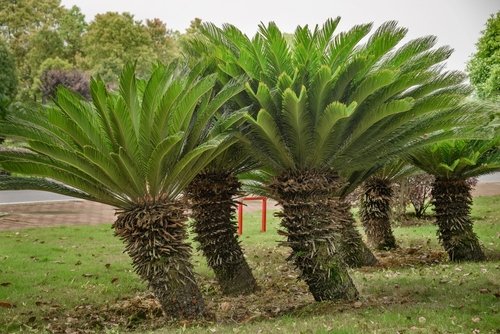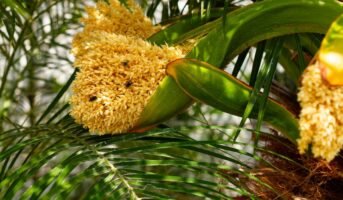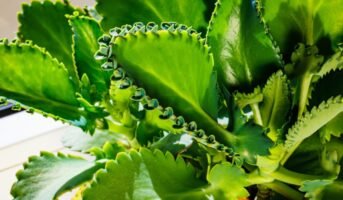What is Cycas Revoluta?
The sago palm tree, or Cycas Revoluta, is one of the most popular decorative plants. While ‘palm’ is a part of their common name, sago palms are not real palms. They belong to cycads, a group of seed plants with ancient roots related to cone-bearing conifers. Cycas Revoluta is believed to be one of the most primitive seed-bearing plants. Due to their reference to ancient times, they are referred to as ‘living fossils’. The species name, Revoluta, means ‘rolled back’ and refers to the plant’s leaves. It is a slow-growing, evergreen, long-living, medium-sized, palm-like plant. The king sago is native to Japan with around 90 species of Cycas that are native to east Africa, Asia, Polynesia and Australia.
The fruits, or cones, are large and develop from the central crown. In most cases, the plants are invariably dioecious, i.e., there are separate male and female plants. They do not flower but produce cones with exposed seeds (gymnosperm), much like pines and fir trees. The leaves grow from the trunk and are shiny and palm-like with spiny tips. The margins of the leaves roll downward. While the male sago grows a cone, the female grows a foliage structure that resembles a basket in the centre upper part of the tree.
See also: Livistona Chinensis: How to grow and care for Chinese Fan Palm?

Cycas Revoluta: Facts
| Native to | Japan |
| Scientific name | Cycas Revoluta |
| Common name | Japanese Sago Palm, Sago palm, King Sago Palm |
| Family | Cycadaceae |
| Genus | Cycas |
| Maximum height | 2 feet indoors; 3-10 feet tall and wide outdoors |
| Sunlight requirement | Bright, indirect sunlight |
| Water | Moist |
| Soil | Well-draining, aerated soil |
| Uses | Parks, gardens, indoor plants and bonsai |
| Foliage colour | Green |
Cycas Revoluta: Description
Cycas Revoluta or sago palm is a species of seed-producing (gymnosperm) of the Cycas genus in the Cycadaceae family. It is a symmetrical plant with a crown of glossy, dark green leaves growing on a thick shaggy trunk of about 20 cm. It is a slow-growing plant and grows up to a height of over 20 feet in a span of 50 to 100 years.
Cycas Revoluta: Types of Sago Palm
Cycas revoluta is widely cultivated and appears in the following varieties:
Cycas rumphii (queen sago)
This variety grows similar to a tree than a shrub, up to a height of 15 feet tall.
Cycas circinalis (queen sago palm)
This tree-like variety of Sago palm grows up to a height of around 10 feet. It is native to India.
Metroxylon sagu (true sago palm)
This is a true palm variety belonging to the botanical family comprising other popular palm trees.
Cycas Revoluta: How to grow?
To grow the plant from the seed, select fertile seeds, put them in a small water tub and see if they float. Floating seeds are not pollinated and would not turn into a plant. The soaking of the seeds hydrates the shells, allowing them to germinate faster. Soak seeds in water overnight. Once the seeds have softened, remove the outer husk. Sow the seeds in a seed starter mix. Keep the seeds moist in a warm, sunny spot. Seeds can take months to germinate so avoid disturbing the seeds. Plant the seeds in well-drained, sandy soil. Cover the pot with plastic to maintain moisture. Transplant the plant to a large container when you notice at least three to four sets of leaves emerging.
Cycas Revoluta: Care tips
Cycas Revoluta, the ornamental plant, can grow in a range of environments and has an easy-care routine. Provide them ample light, well-drained soil, light watering, occasional fertilising and a new pot every couple of years.
Cycas Revoluta: Sunlight requirements
Cycas Revoluta prefers very bright light but can tolerate low light. Keep the plants in an area that gets plenty of bright, indirect sunlight. Avoid direct sunlight or the leaves may get scorched.
Cycas Revoluta: Soil and fertiliser requirements
Cycas Revoluta grows in well-draining, fertile soil. If the soil is dry, thoroughly water the plant. If it is still moist, avoid watering for a few days. You must water them twice every week during the summer and once every week during the winter. Mixing organic material into the soil helps in nutrition. Cycas Revoluta grow best when fed with an equal ratio of nitrogen and potassium. Slow-release sago palm fertilisers aid in consistent feeding with just one or two applications each year.
Cycas Revoluta: Temperature and humidity requirements
These plants love warm, humid conditions. They can briefly tolerate cold temperatures but frost can damage the foliage and temperatures below 23 degrees Fahrenheit will likely kill the plant. Indoors, protect it from drafts and airflow from heating and air-conditioning vents. Temperature fluctuations can damage the plant.
Cycas Revoluta: Pruning requirements
Once a month, trim yellow or dead leaves and dust the fronds with a soft cloth. When you prune dead growth, be sure to prune it close to the trunk. Use a sharp, clean set of pruning shears to maintain its appearance.

Cycas Revoluta: How to propagate?
Cycas Revoluta can be propagated through seeds and removal of offshoots or pups. Propagating from pups can be done by removing the basal shoots growing at the base of the plant or along the trunk. Loose pups can be removed with a small tug. Let them dry for three-four days and then transplant them in well-draining soil. Plant the offset with the bottom half bedded into the potting soil and the pointed end facing upwards.
Keep the pot in a shaded position and water thoroughly. Roots will slowly begin to form and the first leaves appear in several months. Apply a mild dose of fertiliser and water when almost dry. Do not plant pups into the ground unless they have developed roots. Before re-potting, allow the new plants to form a good root system.
To grow the plant from the seed, select fertile seeds, put them in a small water tub and see if they float. Floating seeds are not pollinated and would not turn into a plant. The soaking of the seeds hydrates the shells, allowing them to germinate faster. Soak seeds in water overnight. Once the seeds have softened, remove the outer husk. Sow the seeds in a seed starter mix. Keep the seeds moist in a warm, sunny spot. Seeds can take months to germinate so avoid disturbing the seeds. Plant the seeds in well-drained, sandy soil. Cover the pot with plastic to maintain moisture. Transplant the plant to a large container when you notice at least three to four sets of leaves emerging.
Cycas Revoluta: Common problems
- Cycas Revoluta turning yellow is an indication of overwatering. Water your plant only when the top 3-4 inches of the soil is dry to touch. Use a terracotta or mud pot that does not trap water as the roots are prone to rot.
- The Cycas leaf tips could turn brown due to direct sunlight exposure. Keep the plant in bright indirect sunlight. To avoid a scruffy appearance, trim the leaves or fronds back to the base when they begin to yellow. This will lead to new leaves.
- If yellowing appears on new growth, check for pest infestation. Treat it with neem sprays. Sago palms that appear to have bits of cotton wool glued to their fronds are victims of a long tailed-mealybug infestation.
- Control mealybugs on your sago palms to rid them of sooty mould. Spray it with a jet of water. Insecticidal soap works on mealybugs.

Cycas Revoluta: Uses
- ‘Sago’ is harvested from the Cycas revoluta. This starch is extracted from the plants’ sponge-like centre pith. It is similar to tapioca in both taste and texture and has been the staple food for populations of New Guinea and the Moluccas. A single sago palm yields about 150-300 kg of sago. It is used in various food items and to stiffen cloth material in the textile industry. The seeds and hump (cone) of the upper part of the sago palm are toxic so the plant should be carefully handled.
- Cycas Revoluta has been used as a traditional medicine to cure blood vomiting, skin diseases, hypertension, gastrointestinal problems, cough, blood pressure, hair growth and snake bite.
- Sago Palm fronds are regularly used in the florist industry. Even the dried leaves of this plant are used as accents in floral arrangements. They are cultivated on a wide scale throughout Japan for exportation to Europe. The wood is used in Japan for making boxes, bottle stands and decorative pieces.
See also: Ferns: Are they merely an ornamental plant? Know why you should plant it indoors

Cycas Revoluta: Toxicity
All parts of the Cycas Revoluta plant are toxic. However, its seeds contain the highest level of the toxin cycasin and beta-methylamino-l-alanine, the ingestion of which can be harmful to humans and animals. So, it’s highly advisable to keep this plant out of the reach of kids and pets.
FAQs
How fast does Cycas Revoluta grow?
These plants are slow-growing, gaining only a few inches annually, and may only produce one new frond each year. It can take 10-15 years for Cycas Revoluta to grow large enough to flower. In ideal conditions, they would bloom outdoors once every three years.
Is Cycas Revoluta poisonous?
Cycas Revoluta (sago cycad or palm) is a popular ornamental plant. All parts of the plant are toxic; however, the seeds contain the highest level of the toxin cycasin and beta-methylamino-l-alanine, the ingestion of which can be harmful to humans and animals.
Is Cycas Revoluta an indoor plant?
Cycas Revoluta is one of the oldest household plants. It is commonly grown as a houseplant in temperate climates. Cycas revoluta can thrive both indoors and outdoors. It is ideal for growing in a container, which can be kept outside in summer. Avoid placing them in direct sunlight. When grown indoors, choose a bright east-, west- or south-facing window.
Purnima Goswami Sharma is a freelance writer based in Mumbai, who has been contributing to various newspapers, magazines and portals for the last two decades. Besides being a research writer for various TV shows, she has been a visiting faculty at SNDT for Communication Skills. She hold a master’s degree in English Literature from Mumbai University and a diploma in Communications and Journalism. She writes on diverse subjects like real estate, interiors, education, lifestyle, health, entertainment and environment.
Email: [email protected]











